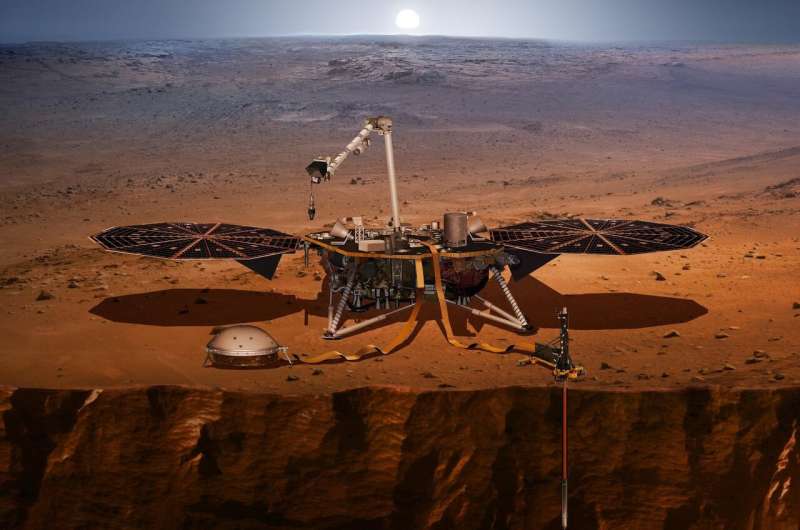This artist's concept shows the InSight lander, its sensors, cameras and instruments. Credit: NASA/JPL-Caltech
An international team of space researchers has learned more about the density of the Martian surface by analyzing data from the Mars InSight lander that was received during Perseverance's descent. In their paper published in the journal Nature Astronomy, the group describes their study of seismic data from InSight as Perseverance dropped heavy blocks during its descent.
One of the ways that planetary scientists learn more about the makeup of other planets is by studying seismic activity—waves from such activity can provide clues to the density of different parts of a planet. In this new effort, the researchers noted that gathering seismic data from extraterrestrial events such as asteroids striking the surface of a planet is difficult as they are so random. But they also noted that the Perseverance mission offered a unique opportunity—as part of its descent earlier this year, the rover's landing craft dropped two tungsten blocks—each weighing approximately 77.5kg to the surface below. The blocks were dropped to help with the craft's lift-to-drag ratio.
Fortuitously, the InSight probe (which has been sitting on the surface since 2018) was situated just 3,450 km to the east of where the blocks landed—a golden opportunity to learn more about the density of the Martian surface. The team also accessed data from Perseverance to determine the altitude and speed of the rocks as they were dropped, which allowed them to calculate the force of the impacts and the time they hit. They were also able to look at the impact sites by accessing high-resolution images from orbiting craft.
In looking at the data from InSight, the researchers found no evidence of the blocks crashing to the surface, which suggested that the surface was of such density that seismic ways created by the impact were muted. They estimate that less than 3% of the energy from the blocks hitting the surface made its way into the material below—a figure that could prove useful when attempting to measure the impact of other space objects. They note that a better understanding of such impacts could prove useful for engineers attempting to build structures on Mars for later human habitation.
More information: Benjamin Fernando et al, Seismic constraints from a Mars impact experiment using InSight and Perseverance, Nature Astronomy (2021). DOI: 10.1038/s41550-021-01502-0
Journal information: Nature Astronomy
© 2021 Science X Network
























